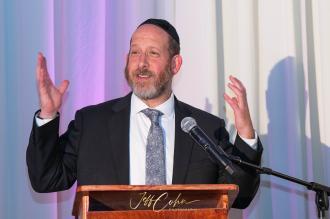Question #1: The Missing Speaker
The audience waited patiently for the guest speaker from America who never arrived, notwithstanding that he had marked it carefully on his calendar and was planning to be there. What went wrong?
Question #2: The Missing Reading
"I will be traveling to Eretz Yisroel this spring, and will miss one of the parshiyos. Can I make up the missing kerias haTorah?"
Question #3: The Missing Parshah
“I will be traveling from Eretz Yisroel to the United States after Pesach. Do I need to review the parshah twice?”
Question #4: The Missing Aliyah
“May I accept an aliyah for a parshah that is not the one I will be reading on Shabbos?”
Introduction:
As we explained in the first part of this article, this year we have a very interesting phenomenon -- there is a difference in the weekly Torah reading between what is read in Eretz Yisroel and what is read in chutz la’aretz for over three months – until the Shabbos of Matos/Masei, during the Three Weeks and immediately before Shabbos Chazon. Since the Eighth Day of Pesach, Acharon shel Pesach, falls on Shabbos, in chutz la’aretz, where this day is Yom Tov, we read a special Torah reading in honor of Yom Tov that begins with the words Aseir te'aseir. In Eretz Yisroel, where Pesach is only seven days long, this Shabbos is after Pesach (although the house is still chometz-free), and the reading is parshas Acharei Mos, which is always the first reading after Pesach in a leap year (Shulchan Aruch, Orach Chayim 428:4). On the subsequent Shabbos, the Jews of Eretz Yisroel already read parshas Kedoshim, whereas outside Eretz Yisroel the reading is parshas Acharei Mos, since for them it is the first Shabbos after Pesach. This phenomenon, whereby the readings of Eretz Yisroel and chutz la’aretz are a week apart, continues until the Shabbos that falls on August 6th. On that Shabbos, in chutz la’aretz parshiyos Matos and Masei are read together, whereas in Eretz Yisroel that week is parshas Masei, parshas Matos having been read the Shabbos before.
Anyone traveling to Eretz Yisroel during these three months will miss a parshah on his trip there, and anyone traveling from Eretz Yisroel to chutz la’aretz will hear the same parshah on two consecutive Shabbosos. Those from Eretz Yisroel who spend Pesach in chutz la’aretz will find that they have missed a parshah.
As I mentioned, there are several halachic questions that result from this phenomenon. Is a traveler or someone who attended a chutz la’aretz minyan on Acharon shel Pesach required to make up the missed parshah, and, if so, how? During which week does he review the parshah shenayim mikra ve'echad Targum? If he will be hearing a repeated parshah, is he required to review the parshah again on the consecutive week? Can he receive an aliyah or “lein” on a Torah reading that is not “his” parshah? These are some of the questions that result from this occurrence.
Searching for a Missing Parshah
At this point, let us examine some of our opening questions. "I will be traveling to Eretz Yisroel this spring, and will miss one of the parshiyos. Can I make up the missing kerias haTorah?"
To the best of my knowledge, all halachic authorities rule that there is no requirement upon an individual to make up a missing parshah (Yom Tov Sheini Kehilchasah, page 239, notes 40 and 41, quoting Rav Shlomoh Zalman Auerbach, Rav Elazar Shach, and disciples of Rav Moshe Feinstein, in his name). Nevertheless, there is a widespread practice to try to find ways of reading through the entire extra parshah. Among the approaches I know are the following:
- Read the entire missed parshah together with the kohen’s aliyah.
- On the Shabbos mincha of the week before one leaves chutz la’aretz, read the entire coming week’s parshah, rather than only until sheini, as we usually do (Yom Tov Sheini Kehilchasah, page 241).
Individual versus tzibur
We should note that there is a major difference in halachah whether an individual missed the week's reading, or whether an entire tzibur missed the reading. There is longstanding halachic literature ruling that, when an entire tzibur missed a week's Torah reading, a situation that transpired occasionally due to flooding, warfare or other calamity, the tzibur would be required to make up the reading that was missed by reading a double parshah the following week (Rema, Orach Chayim 135:2, quoting Or Zarua).
Which parshah?
At this point, let us examine the next of our opening questions:
“I will be traveling from Eretz Yisroel to the United States after Pesach. Do I need to review the parshah twice?”
Let me explain the background to the question. The Gemara (Brachos 8a-b) states: “A person should always complete his weekly parshiyos with the community by reading the Scriptures twice and the targum once (shenayim mikra ve’echad targum).” The targum referred to here is the Aramaic translation of the chumash known as Targum Onkelus. We will leave the details of this mitzvah for a different time, but we should be aware that the Shulchan Aruch (Orach Chayim 285:2) states that one who “fears Heaven” should read both the targum and Rashi.
Our questioner is asking as follows: He will have read each parshah according to the weekly schedule in Eretz Yisroel, and then he will be traveling to chutz la’aretz, where the previous week’s Eretz Yisroel reading will be read. Does the requirement to read the weekly parshah “with the community” require him to read the same parshah again, the next week, since for this week, he is part of that community, notwithstanding that he just read through that entire parshah the week before?
This exact issue is raised by Rav Avraham Chaim Na’eh, one of the great halachic authorities of mid-twentieth century Yerushalayim. Rav Na’eh, usually referred as the Grach Na’eh, authored many Torah works, among them Shiurei Torah on the measurements germane to halachah, and Ketzos Hashulchan, which is an easy-to-read, practical guide to daily halachah. Aside from being a very excellent source of halachah that can be studied by both a layman and a skilled talmid chacham, the Grach Na’eh had a specific unwritten goal to accomplish. Whenever the Mishnah Berurah disputes an approach of the Gra”z (also known as the Shulchan Aruch Harav), the Grach Na’eh presents a brilliant approach explaining how the Gra”z understood the topic and thus justifying that position. The Grach Na’eh himself was a Lubavitcher Chassid, and, therefore, felt a personal responsibility to explain any difficulty that someone might pose with a halachic position of the Gra”z, the founder of Chabad Chassidus.
Returning to our original question, the Grach Na’eh (Ketzos Hashulchan, Chapter 72, footnote 3) rules that a ben Eretz Yisroel is not required to read shenayim mikra ve’echad targum a second time the next week, since he already fulfilled the mitzvah of reading it together with the Israeli tzibur. However, a ben chutz la’aretz who is in Eretz Yisroel should read shenayim mikra ve’echad targum for both parshiyos the week he is in Eretz Yisroel. Since he will be part of an Eretz Yisroel tzibur, he should read that parshah, and he also must read the one of chutz la’aretz, because otherwise, he’ll completely miss studying that parshah this year.
Which one first?
This last point leads us to a new question. Assuming that our chutz la’aretz traveler is now required to read through two parshiyos during the week that will be his first Shabbos in Israel, which parshah does he read first? Does he read the two parshiyos according to their order in the Torah, or does he read first the Eretz Yisroel parshah, which is second in order in the Torah?
Why would he read the two parshiyos out of order?
The reason to require this is because the mitzvah is to read the parshah with the tzibur, and the Torah reading our traveler will be hearing that week is the second parshah since Eretz Yisroel’s reading is a week ahead.
We actually find a responsum on a related question. The Maharsham, one of the greatest halachic authorities of the late nineteenth and early twentieth century, was asked a question by Rav Yitzchak Weiss, who is identified as a rav of Pressburg, Hungary. (You won’t find this city in any map of Hungary today, for two very good reasons: This city is known today as Bratislava, and it is no longer in Hungary, but serves as the capital of Slovakia.)
The question concerns someone who did not complete being maavir sedra one week. Should he complete the parshah that he is missing before beginning the current week, in order to do his parshiyos in order, or should he do the current week first, and then make up the missed part of the previous week?
The Maharsham concludes that he should do the current week first and then the makeup (Shu”t Maharsham 1:213). If we consider our case to be parallel to his, then one should do the two parshiyos in reverse order. However, one could, perhaps, argue that our traveler has an equal chiyuv to complete both parshiyos, since he is now considered a member of two different communities regarding the laws of the week’s parshah. In this case, he should do them in order.
Which aliyah?
At this point, let us look at our final question. “May I accept an aliyah for a parshah that is not the one I will be reading on Shabbos?”
All halachic authorities that I have heard contend that one may receive an aliyah and/or lein without any concerns. The basis for this approach is that there is no requirement to hear a specific Torah reading each week. One is required to hear a Torah reading, and that reading should follow a consecutive pattern. But these details are not requirements that govern an individual’s mitzvah.
This year in Jerusalem…
In these occasional years when Matos and Masei are read separately, parshas Pinchas falls out before the Three Weeks -- and we actually get to read the haftarah that is printed in the chumashim for parshas Pinchas, Ve'yad Hashem, from the book of Melachim. In all other years, parshas Pinchas is the first Shabbos of the Three Weeks, and the haftarah is Divrei Yirmiyahu, the opening words of the book of Yirmiyahu, which is appropriate to the season. The printers of chumashim usually elect to print Divrei Yirmiyahu as if it is the haftarah for parshas Matos, and then instruct you to read it, on most years, instead as the haftarah for Pinchas. What is more logical is to label Divrei Yirmiyahu as the hatarah appropriate for the first of the Three Weeks, and to print both Ve'yad Hashem and Divrei Yirmiyahu after Pinchas; Ve'yad Hashem for the occasional year when Pinchas falls before the 17th of Tamuz, and Divrei Yirmiyahu for the far more frequent year when it falls after, and instruct people that when there is a haftarah to be read just for parshas Matos, they should read Divrei Yirmiyahu which is located as the second haftarah printed after parshas Pinchas. But, then, the printers do not usually ask me what to do, electing instead to mimic what previous printers have done. This phenomenon affects practical halachah, but that is a topic for a different time. However, the printers’ insistence to call Ve'yad Hashem the “regular” haftarah for parshas Pinchas has lead to interesting questions.
Wrong haftarah
The Tzemach Tzedek, the third Lubavitcher Rebbe, was asked the following shaylah. A shul read the haftarah Ve'yad Hashem for parshas Pinchas when it fell during the Three Weeks, which is the wrong haftarah (they should have read Divrei Yirmiyahu), and now it is parshas Matos/Masei. Which haftarah do they read, Divrei Yirmiyahu which is the one for the first of the Three Weeks, or the one for the second of the Three Weeks, which begins with the words Shim’u dvar Hashem?
He says that because these two chapters, Divrei Yirmiyahu and Shim’u dvar Hashem are next to one another, they should begin with Divrei Yirmiyahu and read them in order, both together, as one long haftarah (Shu”t Tzemach Tzedek, quoted by Maharsham). Those who are unhappy about this decision of reading what is, in essence, a doubled haftarah, should take it up with their gabbai, or, if they prefer, with the printers, who should have placed Divrei Yirmiyahu after parshas Pinchas!
End of Shim’u dvar Hashem – Nice or near?
By the way, there is a difference between the way the Sefardim and the Ashkenazim end this haftarah. The passage Shim’u dvar Hashem does not end on the most pleasant topic, and we try to close our haftaros on a positive note. For this reason, both Ashkenazim and Sefardim skip ahead to find a nice way to end the haftarah, but we don’t jump to the same place. Ashkenazim skip to the pasuk Halo Mei’atah, which is twelve pesukim ahead, whereas Sefardim jump ahead further, to the two heart-warming pesukim that begin with Im tashuv Yisroel, which are over thirty pesukim ahead. In this instance, it appears that Sefardim elected to go with the nicer conclusion, whereas Ashkenazim elected the nearest appropriate ending.
Conclusion
We see the importance of reading through the entire Torah every year. We should place even more importance in understanding the Torah’s portion well every week and putting it into practice.
















